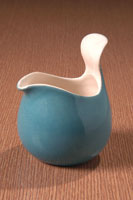Along with steel-toe boots, most folks know Red Wing, Minn., for its hand-turned stoneware. By all odds, you’ve come across at least one gray crock with that signature stamp—be it on grandma’s kitchen shelf or in an antique shop. But stoneware is just the beginning.
This postcard-perfect town on the Mississippi’s southwestern bank has adapted to the times like clay in a potter’s hands. In the course of a century, Red Wing pottery evolved from manual to industrial, rural to urban, sensible to stylish. Whether you’re a history buff or a full-blown wing nut, you’ll appreciate the amazing variety of eras, patterns and products that make up Red Wing Retro: Extraordinary Pottery, Everyday Life, now on display at the Minnesota History Center.
At one corner of the exhibit space, an antique hutch holds a variety of salt-glazed and Bristol-glazed stoneware from the late 1800s to early 1900s: jugs that once stored liquor or syrup; low jars for butter or cottage cheese; milk pans, barrel mugs, bean pots and more. Beside the hutch, a recipe from Home Packing and Preserving the Red Wing Way proclaims the many virtues of sauerkraut, while a farm kitchen scene highlights the sauerkraut brining process of 19th- and 20th-century Minnesota. At the opposite end of the room, 15 Red Wing crocks—from two to 60 gallons—spiral toward the ceiling. Weighing in at 200-plus pounds, the 60-gallon crock, with lid still intact, is an especially rare find.
Thanks to its small size and back-to-basics design, the earliest piece within the exhibit, a one-quart mustard pitcher produced between 1878 and 1906, could easily go unnoticed. But in today’s collector circles, simplicity is of the utmost demand. “It’s cool to think about what these objects were used for, like threshing jugs for people working in the fields,” says Sue Jones Tagliapietra, president of the 6,000-member Red Wing Collector’s Society (RWCS) and a longtime stoneware collector. “The imperfections also attract you to the pieces, like the ‘turkey droppings’ from the salt glaze or the handprints of the person who decorated it.”
A German craftsman and Minnesota transplant, John Paul was among the first to find natural clay deposits near Red Wing in 1861. He and his fellow settlers spent the next two decades crafting a wealth of wares to meet the demands of farm life. Close proximity to railroads, river barges and the burgeoning grain industry made the city a potter’s paradise. As an upshot, Red Wing Stoneware was established in 1878, followed by Minnesota Stoneware in 1883, then North Star Stoneware in 1892. When the three entities merged in the early 1900s, the small town of Red Wing boasted the largest pottery company in the United States.
To accommodate this tremendous growth, the Red Wing potteries industrialized at the turn of the century, replacing the craftsman’s process with an assembly line and applying their famous logo to every piece. Though the machines and molds made production more efficient, the work was grueling nonetheless. Exhibit-goers can watch the factory workers in action via clips from KSTP’s Newsfilm Archive.
By the time the company incorporated to become Red Wing Potteries, Inc. in 1936, it had switched its focus from stoneware to art pottery. A wall display of glazed artware, produced between the 1930s and 1960s, features classic vases, kitschy animal planters and everything in between. New York-based designer Belle Kogan, who produced her first commissions around 1939, turned out hundreds of pieces for the company. Her glossy orange “Prismatique” bowl, inspired by the complex geometry of a tooth’s roots, is a standout item within the display.
As the postwar economy began to shift from agrarian to urban, the company responded with affordable, hand-painted dinnerware. Platters and salad plates, cups and saucers, cereal bowls and creamers accounted for nearly 85 percent of stock by the early 1950s. Red Wing Retro pays tribute to this new era and new business strategy with a period dining room and kitchen—avocado dishwasher included—showcasing patterns such as Belle Kogan’s “Plum Blossom” and Eva Zeisel’s “Town and Country.” Charles Murphy’s bestselling “Bob White” pattern (which, incidentally, served as a background prop in a 1956 Playboy centerfold) rounds out the exhibit, as do many of the artware and dinnerware patterns he created as the company’s resident designer.
Ron Linde, president of the RWCS Foundation, was one of several experts who worked closely with the Minnesota History Center to develop Red Wing Retro. “The curator and exhibit designers wanted to add to their historical knowledge of the potteries,” he says. “Our board gave them suggestions for items they might use in the exhibit and we also put them in touch with people who could loan items.” At the entrance to the space, visitors pass a wall of 50 hand-painted dinner plates, adorned with flowers, birds, fruit and other vibrant patterns, many of which Linde readily loaned from his private collection.
Red Wing Potteries, Inc. continued to flourish until labor became cheaper overseas. Following a long strike, the company closed its doors in 1967. Today, the old factory building houses Pottery Place Mall and the Red Wing Pottery Museum, while Red Wing Pottery and Shops, launched in 1996, has found success as a third-generation business. “Red Wing Retro highlights a company that is not only an essential part of Minnesota’s heritage, but is also notable for its innovation in the face of a changing marketplace,” says senior curator Marcia Anderson. Indeed, after all these years, Red Wing’s legacy continues to thrill consumers, collectors and curators alike.
the company closed its doors in 1967. Today, the old factory building houses Pottery Place Mall and the Red Wing Pottery Museum, while Red Wing Pottery and Shops, launched in 1996, has found success as a third-generation business. “Red Wing Retro highlights a company that is not only an essential part of Minnesota’s heritage, but is also notable for its innovation in the face of a changing marketplace,” says senior curator Marcia Anderson. Indeed, after all these years, Red Wing’s legacy continues to thrill consumers, collectors and curators alike.
Shards dating back to the Stone Age tell us that, long after we’re dead and gone, our clay vessels will remain. Assuming the world still exists a millennium from now, what relics of everyday life will people remember America by? Will future archeologists dig deeper than the Tupperware and Styrofoam to find something beautiful, something that reflects our ingenuity at its best? Let’s hope they bring their picks and shovels to Red Wing, where they’re bound to dig up some 100 years of ingenuity. W
Red Wing Retro: Extraordinary Pottery, Everyday Life runs through Dec. 31 at the Minnesota History Center, 345 W. Kellogg Boulevard, St. Paul, 651-296-6126.






